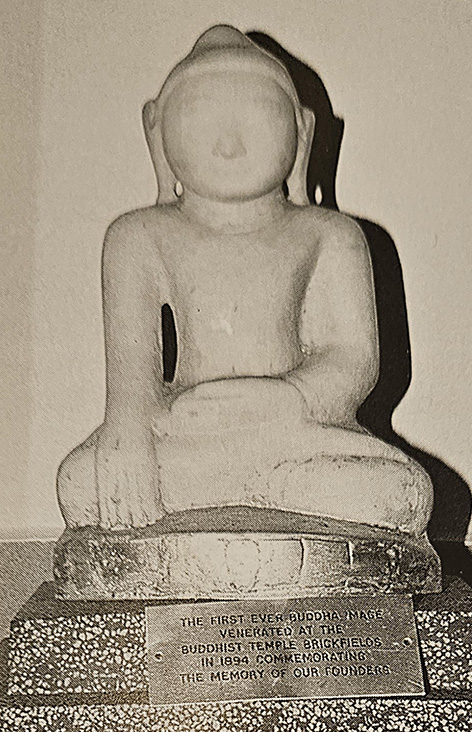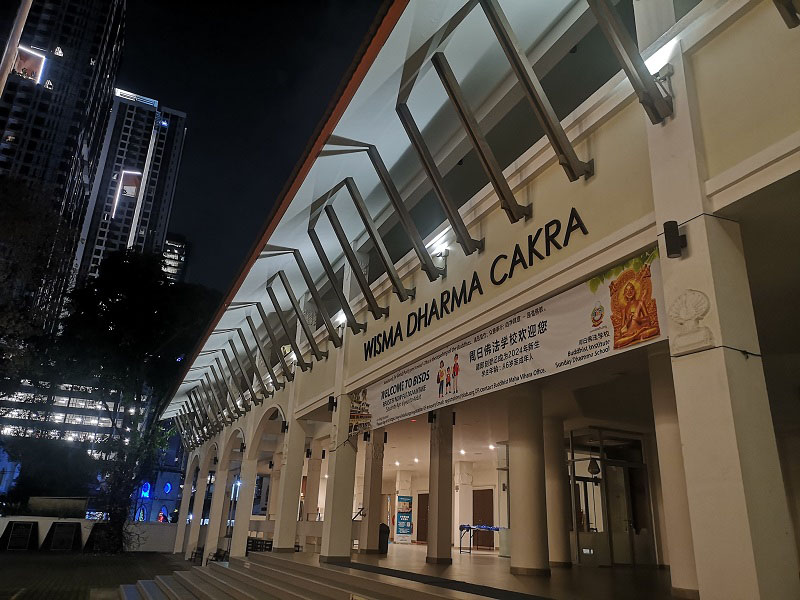Buddhist Maha Vihara, Sanctuary of Peace and Wisdom in Spiritual Kuala Lumpur
by Kooi F. Lim, The Buddhist Channel, 29 Feb 2024
Kuala Lumpur, Malaysia -- In heart of Jalan Berhala (Temple Road), where churches, mosque and Hindu temples lined its street, a grand temple - the Buddhist Maha Vihara - stands as a beacon of the Buddhist faith. As one steps through its "Sanchi inspired" gates, they are embraced by a sense of calm, a refuge from the frenetic pace of this modern city.

Buddhist Maha Vihara Main Shrine Hall today
Here, amidst its tranquil lotus fountain and shrine halls towered by skyscrapers that have mushroomed around it, the journey of self-discovery begins anew. Welcome to where ancient wisdom of the Buddha flourishes, guiding Dharma seekers on a path of insight and boundless compassion.
The Sanchi gate at Madhya Pradesh, India (left) and the Buddhist Maha Vihara gate
The Buddhist Maha Vihara (BMV) holds a significant place in the heart of Kuala Lumpur, tracing its roots back to 1894 when the Sasana Abhiwurdhi Wardhana Society (SAWS) laid its foundation. Managed by the Sinhala Buddhist community from its inception, the Vihara stands as a testament to the rich heritage of the Sinhalese community and their steadfast dedication to the Buddhist faith.
Here is their story.
Malaya and the Early Sinhala Community
In the pioneering years of colonial Malaya, the vast majority of the Sinhala immigrants were Buddhists, so much so that members of the local Sinhala community in general were often referred to and identified as being Buddhists by the other communities. To a substantial degree the terms "Sinhala" and "Buddhist" were consequently regarded as being synonymous.

View of the shrine hall (circa 1926)
One critical reason how and why the BMV became an important Buddhist institution is due to the Sinhala community being proud of their past, of their inherited traditions, religious values and their time-honoured way of life. They take pride in the fact that they had preserved early Buddhist teachings through the Pali Tipitaka - which had been lost in India at a comparatively early date. This effort was a landmark contribution by the Sinhala people to the world of Buddhist literature and historiography.
Problems faced by early Sinhala ImmigrantsOn their arrival, the early Sinhala pioneer Buddhist immigrants found themselves in a strange country with a different way of life, religion, customs, language and diet. It must have indeed been a culture shock. Conditions in the country too must have been bewildering to them.
In many cases the wives did not accompany the early migrants. Liquor was relatively cheap and plentiful in those early days. Consequently addiction to liquor became a serious social problem affecting a section of the early Sinhala pioneers, who could also have become indebted in order to sustain their drinking habits, and this eventually prompted a move which led to the formation of a temperance society, known as the
Amaddya Pana Samagama, to overcome the problem.
These early settlers also faced shortcomings particularly with regard to their performance of religious obligations. There were then no Theravada Buddhist temples and no monks. Cases had occurred where certain Sinhala Buddhists had died and were interred without even the proper last religious rites being administered.
Of course, there were Chinese temples in existence but these could not be regarded as being Buddhist because in those days they were mainly devoted either to ancestral worship by various clans or to the worship of various deities, with their own peculiar rites and rituals. However, these were alien to the Theravada practices of the Sinhala Buddhists.
There were also temples closely associated with Chinese secret society activities. Non-Chinese entering such temple premises were often viewed with suspicion by the Chinese temple caretakers.
There was therefore a need for a proper place of worship for the Sinhala Buddhists in accordance with their Theravada tradition as well as for a burial ground for the community.
Inaugural Meeting of Sinhala BuddhistsThe inaugural meeting of Sinhala Buddhists in February 1894 marked an important point in the Vihara's history. The object of the meeting was to seek government assistance in acquiring a piece of land for the development of a Buddhist Temple.
According to the minutes of the meeting it was recorded:
1) that there was a need for a Buddhist temple in Kuala Lumpur as there were over 200 members of the Sinhalese community in Selangor, the majority being Buddhists;
2) that it was beyond the means of the Sinhalese Buddhists to purchase an allotment of Government land needed for a temple site;
3) that the site desired be located at Batu Limabelas (the former name for the whole of the Brickfields area) in the vicinity of the Public Works Department (PWD) Factory where the majority of Sinhalese lived; and
4) that Buddhist monks would be brought from Ceylon for the supervision and running of the temple and for the administration of last rites for deceased Sinhalese Buddhists prior to interment.
Petition for land for a Buddhist temple
First ever Buddha image setup for veneration at the BMV
In that meeting, a petition by Sinhala Buddhists addressed to W.H. Treacher, the British Resident, Selangor was prepared on 20 February 1894 seeking Government assistance to grant a 2 acre piece of State land on which to erect a Buddhist temple. The petitioners suggested that Government land on Lot 19 Section 55 be cited as being most suitable.
The British government responded to the request but said any land in the administration capital intended for public service can only be granted towards an organisation. After a thorough discussion among the community, they agreed to form an organisation called the Sasana Abhiwurdhi Wardhana Society (SAWS - "Sasana", pali word for teachings of the Buddha, "Abhiwurdhi Wardhana" sanskrit words meaning progress, development). The founding President of SAWS was the late T. A. Gunasekera.
With the forming of SAWS, together with Amaddya Pana Samagama, they became the institutions responsible resolving social issues among their community. Ironically, SAWS and its subsidiary Amaddya Pana Samagama are listed as the 5th and 6th registered societies according to the records kept at the Registrar of Societies, Selangor. In other words, they are considered as the pioneering registered societies in the country. The formation of SAWS also witnessed the laying of the foundation stone for the temple shrine room on 25 August 1894.
Through the inaugural meeting among the community, they agreed that the appointment of the temple abbot should be from British Ceylon and the temple administration would be under Sinhalese hands. A living quarters was then built to house the first resident monk Ven. Patthalagedera Dhammananda Thera. His student Godagama Sobhita Thera from British Ceylon later arrived in 1895, which also marked the foundation of the temple in the same year.

First resident monk of the Buddhist Maha Vihara,
Ven. Patthalagedera Dhammananda Thera
Growth and Support of Buddist Maha Vihara (BMV)
Throughout its journey, the Buddist Maha Vihara has been sustained by the collective support of diverse communities. The construction of its first structure, the Main Shrine room, was made possible through contributions from Chinese and Indian donors. Among the big donors are the Chinese Kapitan of Kuala Lumpur, Yap Kwan Seng.
This spirit of solidarity continued through collaborative events such as protests against controversial films and campaigns for religious holidays.
During tumultuous periods like the Emergency of 1948-1960, the Vihara's monks played a crucial role in providing solace and guidance to affected communities.
In 3 April 1962, a pivotal moment in Dhamma propagation in the history of Malaysian Buddhism occured when the Buddhist Missionary Society (BMS) was formed. Under the guiding light and motivating force of the late Chief Venerable K. Sri Dhammananda, Dhamma based outreach (towards the Buddhists) and education became more organised and systematic. Malaysian Sinhalese and Chinese Buddhist leaders worked hand in hand to formulate programmes, provide free Dhamma publications (in the form of booklets) and Sunday Dhamma talks in effort to reach out to non-Sinhalese Buddhists.

First Buddhist Missionary Society Management Committee 1962. The monks seated in the front row are Ven. Dr K Sri Dhammananda and Ven. Ananda Mangala
The formation of the BMS widened Dhamma outreached and eased the burden of SAWS of propagating Buddhism in the country. Its commitment to spreading the teachings of Buddhism led to initiatives such as and the establishment of the Buddhist Institute Sunday Dhamma School, enriching the lives of countless young individuals.
The Vihara's enduring legacy extends beyond religious boundaries. Its annual Wesak procession, the country's oldest and largest, attracts thousands in celebration.
In times of crisis, such as the South Asian Tsunami of 2004, the Vihara served as a disaster relief centre, mobilizing relief efforts on a massive scale.
Buddhist Maha Vihara, Kuala Lumpur's Buddhist Icon

Today, guided by a clear vision and mission, the BMV remains steadfast in its dedication to the Buddhist community. As it continues to evolve and serve, its success stands as a testament to the unwavering commitment of its past and present custodians, one of which includes its most famous monk, the late Chief Venerable Dr. Kirinde Sri Dhammananda, whose significant contributions are etched in the annals of Malaysian and world Buddhist history.
-------------
Source: H.M.A de Silva, 100 Years of the Buddhist Maha Vihara (1895-1995), Published by Sasana Abhiwurdhi Wardhana Society, 1998.
Read also:







